23 May 2025
Global Market Outlook
Global Market Outlook
Riding the tariff relief rally
We raise global equities to Overweight. US trade policy risks have eased, and market technical indicators have improved. More trade deals and relative resilience in economic activity data and corporate earnings estimates are key to sustaining the rally.
Upgrade US equities to a small Overweight. The ‘Sell America’ trade is overdone. However, we will continue to diversify across major regions. We are Overweight China within Asia ex-Japan, given policy stimulus and a softer USD.
Downgrade gold to a core holding, as we expect a period of consolidation ahead. High-quality bonds remain attractive at today’s elevated yields.
What next after the relief rally?
What are the key macro scenarios to consider?
Are quantitative models still bullish on equities?
Strategy
Investment strategy and key themes
|
|
||||
|

12m Foundation Overweights:
- Equities
- US equities
Opportunistic ideas – Equities
- US software, communications, major banks, semiconductors
- China non-financial high dividend SOEs and Hang Seng Technology Index
- European banks, industrials
Opportunistic ideas – Bonds
- US Agency mortgage-backed securities (MBS)
- UK Gilts (FX unhedged)
- US 20-year-plus government bonds
- US Treasury Inflation-Protected Securities (TIPS)
Riding the tariff relief rally
- We raise global equities to Overweight. US trade policy risks have eased, and market technical indicators have improved. More trade deals and relative resilience in economic activity data and corporate earnings are key to sustaining the rally.
- Upgrade US equities to a small Overweight. The ‘Sell America’ trade is overdone. However, we will continue to diversify across major regions. We are Overweight China within Asia ex-Japan, given policy stimulus and a softer USD.
- Downgrade gold to a core holding, as we expect a period of consolidation ahead. High-quality bonds remain attractive at today’s elevated yields.
Blowing hot and cold
US trade policy has undergone three major changes over the past two months. ‘Liberation Day’ (2 April) brought higher-than-expected tariffs. Subsequently, on 9 April, Trump paused most tariffs for 90 days to focus on trade talks. More recently, the US announced the outline of a ‘deal’ with the UK and start of US-China trade talks. Markets have followed this flip-flop, with the S&P500 falling about 20% peak-to-trough at one point, before recovering most of the losses and turning positive year-to-date.
The most important question today is whether the equity rebound has legs in the long term or whether we see a renewed relapse in the near term. To help answer this, we focus on two key upcoming event risks.
First is trade policy. We expect more trade deal conclusions sustaining the rally – especially with the 90-day tariff pause ending in early July. Second is economic data. We expect relative resilience in hard data (i.e., real economic activity) to sustain market gains, despite the recent weakness in soft sentiment data from surveys. Progress on Trump’s deregulation agenda should also offer support.
As a base case, we still expect the US economy to achieve a benign soft landing, with growth slowing below trend. However, a hard landing remains a risk. The latest US sovereign rating downgrade highlights ongoing concerns about US fiscal deficits, though we would view a significant impact on bond markets as more of a tail risk.
Fig. 1 Near-term equity market outlook positive, despite uncertainty after the 90-day tariff pause expiry
Our short-term S&P500 technical model
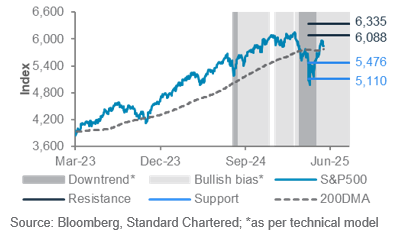
Overweight equities, for now
Given the risks, it is fair to question why we are upgrading equities back to an Overweight.
A sharp improvement in the near-term outlook drives our more constructive view on global equities. Our short-term (one- to three-month) technical models have turned bullish for US and China equities. This means a test, or a break above, the S&P500’s prior record high can be expected. Our longer-term stock-bond model has also turned modestly bullish on global equities, but this is also driven by technical (rather than fundamental) drivers. The reasonably long period between now and early July (when the US 90-day tariff pause ends) creates room for equity momentum to run further, especially if a few more trade deals are signed and Trump is able to implement his deregulation and tax agendas.
Regionally, we have a slight preference for US equities. The Q1 earnings season was strong, and the ‘Sell America’ trade was arguably excessive, given resilient earnings.
Having said that, we continue to emphasise the importance of ensuring adequate diversification across regions. We view Euro area and Asia ex-Japan equities as core holdings, with pullbacks as opportunities to rebalance. Within Asia ex-Japan, we are Overweight Chinese equities, given the additional support from domestic stimulus. We retain Indian equities as a core holding, given a possible US-India trade deal, strong earnings growth and foreign investor inflows. Both markets should benefit from a weaker USD.
Gold to consolidate near term
We reduce gold to a core holding and expect prices to approach USD 3,100/oz over the next one to three months. After the surge in prices this year, we see a period of consolidation before the next leg higher. This is a pattern witnessed several times since 2022 and illustrates major buyers display a degree of price sensitivity in the current environment. Over a longer-term, 6-12-month horizon, we expect gold to make a renewed move towards USD 3,500/oz as major central bank buying resumes.
Fig. 2 US bond yields are attractive as they approach top of their recent range
US 10-year government bond yield and our expected range
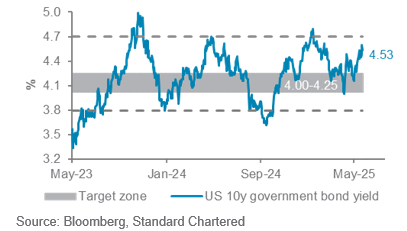
Add to high-quality bonds
US government bond yields have rebounded following the rebound in risk appetite and Moody’s credit rating downgrade.
We view bonds as a core holding and believe it is attractive to buy high-quality bonds at current yields. Short of an unexpected inflation shock, the US 10-year government bond yield is expected to fall (i) to the 4.00-4.25% range in our base soft-landing scenario and (ii) below 4% in a hard-landing scenario. A jump in yields on the back of US fiscal deficit concerns is a key risk, highlighted by the US credit rating downgrade. However, studies of sovereign credit stress over the last few centuries argue debt imbalances can persist for long periods. This argues the case for viewing this as more of a tail risk in the absence of a trigger.
We now see attractive value in longer maturity bonds, which offer exposure to an expected move lower in yields.
US dollar – higher then lower
We expect the US Dollar index (DXY) to rebound over the next 1-3 months and then weaken over 6-12 months.
In the near term, renewed appetite for US assets and closing of earlier bearish positions should offer support for the USD. This should reduce demand for safe haven currencies, typically with low borrowing costs. However, we expect this USD bounce to be temporary. Ongoing rotation out of US assets and elevated USD valuations are likely to lead to a modestly weaker USD in the longer term.
Opportunistic ideas
Within equities, we opportunistically turn bullish on US-listed semiconductor sector equities, which we expect to benefit from the ongoing rally in US cyclical sectors. Within bonds, we also opportunistically turn bullish on (i) 20-year-plus US government bonds and (ii) UK government bonds (FX-unhedged).
Foundation asset allocation models
The Foundation and Foundation+ models are allocations that you can use as the starting point for building a diversified investment portfolio. The Foundation model showcases a set of allocations focusing on traditional asset classes that are accessible to most investors, while the Foundation+ model includes allocations to private assets that may be accessible to investors in some jurisdictions, but not others.
Fig. 3 Foundation asset allocation for a balanced risk profile

Fig. 4 Foundation+ asset allocation for a balanced risk profile
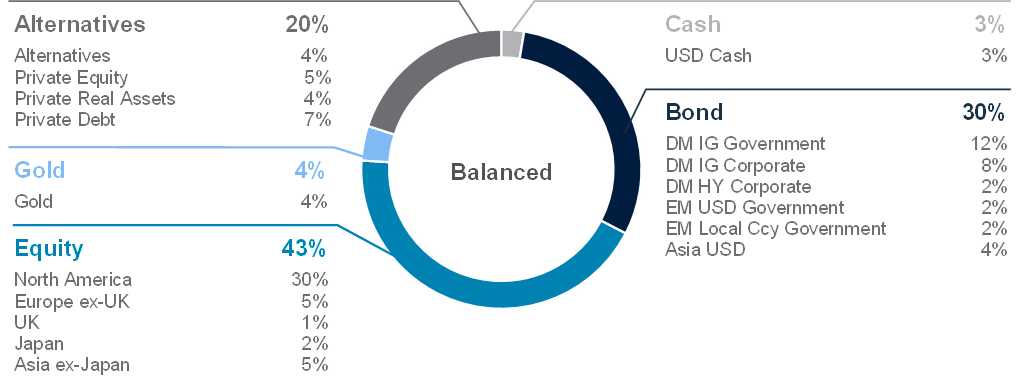
Fig. 5 Multi-asset income allocation for a moderate risk profile

Source: Standard Chartered
Foundation: Our tactical asset allocation views
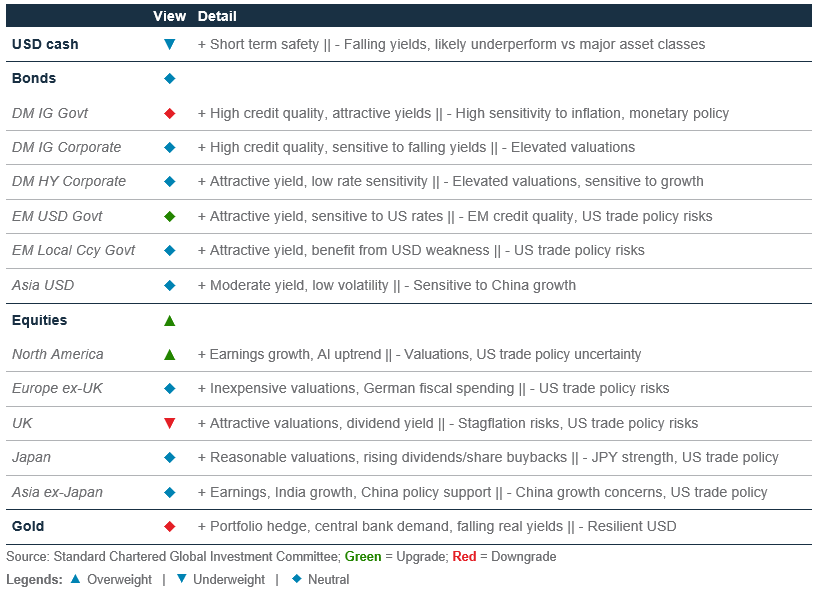
Fig. 6 Performance of our Foundation Allocations*
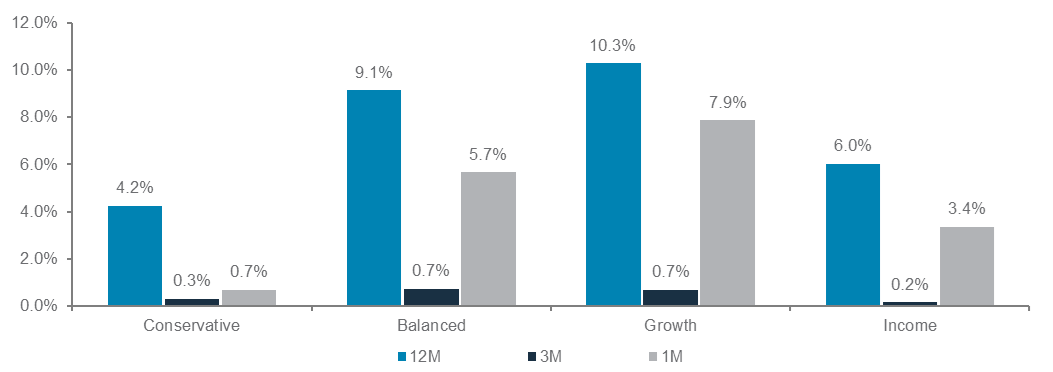
Source: Bloomberg, Standard Chartered; *12-month performance data from 22 May 2024 to 22 May 2025, 3-month performance from 22 Feb 2025 to 22 May 2025, 1-month performance from 22 Apr 2025 to 22 May 2025.
Perspectives on key client questions
|
|
||||
What’s next after the relief rally?
- The US-China trade truce supports a constructive stance on risk
- However, uncertainties remain – we outline three key scenarios
- Diversification remains crucial to navigate the uncertainties ahead
Market dynamics have shifted notably in recent weeks. Trade tensions that once weighed on sentiment have eased considerably, paving the way for a sharp rebound in US equities. The US administration has demonstrated pragmatism, with an apparent desire to avoid economic self-harm. Combined with resilient macro data and solid corporate earnings, these developments have narrowed the range of potential outcomes for risk assets, reducing the likelihood of a sharp drawdown in equities.
The US-China truce on trade has reduced the risks of a US economic hard-landing and supports a more constructive stance on risk. However, the road ahead will be bumpy, requiring careful navigation by investors. A divergence between ‘hard’ and ‘soft’ economic data has emerged – hard economic data remains resilient, while soft survey data signals fragility, raising the risk that hard data may eventually weaken. Risk assets have also priced in much of the recent optimism, and with US equity valuations again elevated, further gains will hinge on meaningful progress on trade negotiations and Trump’s proposed ‘Big Beautiful (tax cut) Bill’, which we expect to dominate the market narrative in the coming months.
Mapping the path ahead
To help investors navigate the uncertainties ahead, we outline three potential scenarios shaped by developments in trade and fiscal policy. Our core scenario is that the US will ultimately be able to achieve a soft-landing, but not without navigating significant volatility and challenges along the way. Trade talks are still in their early stages, while the budget bill raises the risk of delays and policy uncertainty.

Fig. 7 Our core scenario involves an economic soft landing, but there are significant risks around this scenario
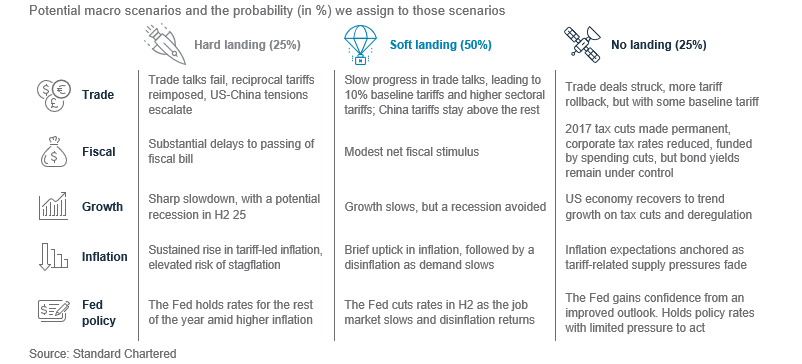
Fig. 8 US ‘hard’ data has been resilient, but weakening ‘soft’ data signals underlying fragility
US ‘soft’ vs ‘hard’ data
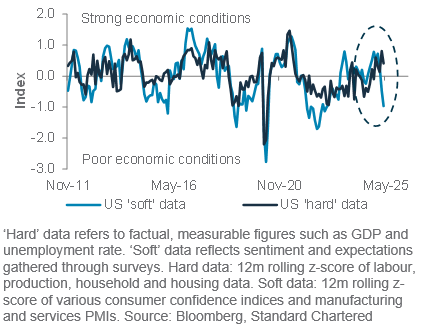
Soft landing: our core scenario
In this scenario, Trump struggles politically, with policy gridlock stalling progress on his agenda, contributing to prolonged uncertainty. However, trade negotiations do yield results, while a scaled-down version of the tax bill eventually passes Congress. Crucially, US growth slows but escapes a recession as the Fed cuts rates from H2. Market volatility is likely to persist in the near-term, particularly as key deadlines for Trump’s 90-day pause on reciprocal tariffs and the proposed tax bill converge in July. But investors who remain patient would be rewarded as resilient earnings underpin gains in the S&P 500. Our 12-month target for the S&P 500 is at 6,520, 12% higher from current levels.
Hard landing: short-dated bonds and gold preferred
This scenario is the least conducive for US growth and risk assets. The S&P 500 revisits year-to-date lows, before falling further to around 4,500 as hard economic data deteriorates. The US 10-year bond yield falls below 4%, but
downside is limited by rising inflation and term premia, even as the Fed cuts rates. Only short-dated government bonds, safe-haven currencies and gold offer refuge.
No landing: US equities and riskier bonds to outperform
US equities and riskier bonds outperform, putting to rest the ‘Sell America’ narrative. The S&P 500 rises to 7,000 over a 12-month period, gaining 20% from current levels. Foreign demand returns for US government bonds, but better risk sentiment, limited pressure for the Fed to act, and lingering deficit concerns keep 10-year yields within the 4.5-5.0% range.
Fig. 9 Our strategies have performed well amid recent market volatility
Max drawdown in April of various strategies
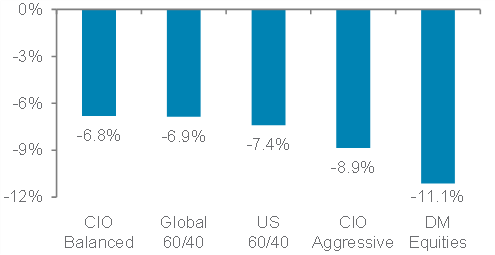
Diversification remains crucial to navigate uncertainties
The complex outlook calls for tempered optimism. In this nuanced backdrop, diversification remains crucial. While the S&P500 has eked out gains for the year, other regions and sectors, such as European equities and the Chinese technology sector, have outperformed. Our strategies have also delivered lower drawdowns compared to traditional 60/40 portfolios and global equities. This underscores the value of active diversification – not just across asset classes but across geographies and strategies as well.
Fig. 10 Our core soft landing scenario implies equities outperforming bonds; USD weakness could benefit EM assets
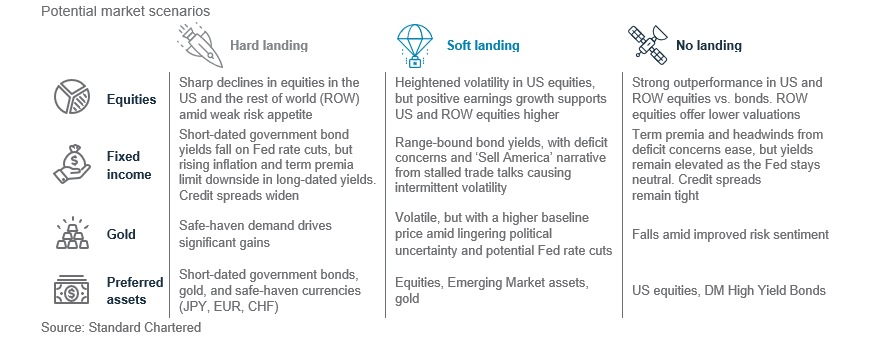
Macro overview – at a glance
Our macroeconomic outlook and key questions
|
Key themes
Core scenario (soft landing, 50% probability): The US-China trade truce has reduced the chance of a US economic hard landing. Although still-elevated tariffs will slow growth and lift inflation, the focus will move to trade deals, tax cuts and deregulation. We expect the resulting improvement in consumer and business sentiment to help the US avert a recession. As the job market cools, we expect the Fed to cut rates by 75bps over the next 12 months, starting from H2. Meanwhile, fiscal and monetary policy easing in China and Europe (especially Germany) should broaden growth beyond the US.
Downside risk (hard landing, 25% probability): Depressed US consumer and business sentiment, worsened by renewed trade tensions, could hurt real activity data. Even if the Fed hastens rate cuts, the US could experience a mild recession, dragging global growth. A surge in US bond yields due to unfunded tax cuts and a USD sell-off is another risk to the soft-landing view.
Upside risk (no-landing, 25% probability): Cuts to US government spending and taxes and deregulation could revive private sector ‘animal spirits’. Meanwhile, the US could use tariff pressure to finalise trade deals and seal a ‘grand bargain’ with China, boosting domestic consumption in China and investment in Europe. This could lead to a more balanced global economy.
Key chart
The US-China temporary tariff truce has eased global trade uncertainty. However, investors’ focus will turn to incoming ‘hard’ data to see if US policies have further damaged the already softening labour market.
Fig. 11 As global trade uncertainty eases, the focus shifts to US ‘hard’ data
US and China trade policy uncertainty indices*; US unemployment and job opening rates

Macro factors to watch
US trade deals, tax cuts and deregulation: The US-China truce and the preliminary US-UK trade deal set the tone for US talks with key partners. The UK deal suggests a 10% baseline tariff will apply to all US imports, which partly pays for proposed tax cuts. China will face a higher tariff than the baseline but not as high as 50-60% initially feared. Strategic sectors, such as steel, aluminium, autos and semiconductors, will face restrictive (higher-than-baseline) tariffs.
Even after the US-China temporary tariff rollbacks and likely consumption shifts, the US average tariff rate will be 16.4%, the highest since 1937, according to the Yale Budget Lab. This is estimated to cut US growth by 0.7% and lift inflation by 1.7% in the short term. Hence, there is an urgency for the administration to enact tax cuts and deregulation in the coming months. We expect a modest net fiscal stimulus from the tax cuts due to pressure from the bond markets. A weaker job market will allow the Fed to start cutting rates in H2.
German fiscal boost, trade thaw to limit ECB rate cuts: Europe’s economic revival significantly rests on how soon the new German government implements its 12-year, EUR 500bn infrastructure spending plan (equivalent to 1% of GDP per year) and off-budget defence spending that were recently approved by the parliament. Euro area PMI data showed service sector (70% of the economy) slowed in May. However, Germany’s fiscal spending plan and a US trade deal would reduce the chances of ECB rate cuts. We expect one more 25bps ECB deposit rate cut in June, followed by a long pause.
US-China trade talks, stimulus: The US-China temporary trade truce has arguably removed the worst-case scenario of an all-out trade war. It also underlined the so-called ‘Trump put’ remains in place – that US trade policy is likely to be restrained by markets. However, China continues to face deflationary pressures, and still-elevated US tariffs are likely to continue to weigh on growth and prices. Hence, we expect Beijing to keep easing monetary and fiscal policies, including further bank deposit rate cuts, to help achieve its c.5% growth target for this year.
Asset Classes
Bonds – at a glance
|
|
||||
Key themes
Foundation: We downgrade DM government bonds to a core holding but still believe current yield levels offer an attractive entry point. Worries about inflation and the US fiscal deficit have pushed yields higher, but we expect yields to eventually fall in both soft and hard landing scenarios. An unexpected surge in inflation expectations due to tariffs is the key risk.
New opportunistic view: Turn bullish US 20-year-plus US government bonds. We believe the recent rise in 20-year+ US bond yields to the upper end of their recent trading range makes them attractive. A surge in inflation expectations is a risk.
New opportunistic view: Turn bullish UK government bonds [Gilts] (FX-unhedged). We like the nominal yield pick-up over other Developed Market (DM) government bonds and believe the Bank of England is in a better position to cut rates relative to peers. Risks include stronger-than-expected inflation, wage growth and significant GBP weakness.
Outstanding opportunistic views: Bullish US Agency MBS; bullish US Treasury Inflation-Protected Securities.
Key chart
Bond returns should be supported by further DM central bank rate cuts in H2 25. However, corporate bond yield premia have tightened again to their one-year average lows.
Fig. 12 Major DM central banks remain dovish; Global bond yield premia have partly reversed the March-April widening episode
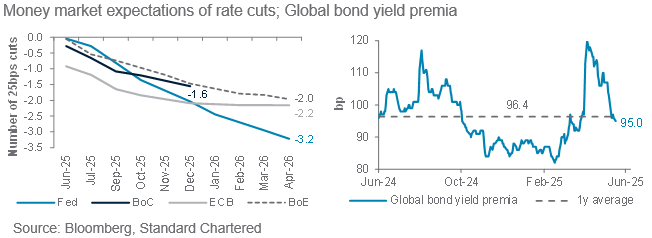
We continue to view global bonds as a core holding. In our base soft landing scenario, we expect bond returns to be supported by falling yields from current levels, helping them outperform cash which does not offer protection against lower central bank interest rates. High quality bonds should also offer diversification benefits (in a low or falling inflation outcome) particularly in a hard landing risk scenario.
Current nominal bond yields are near the upper end of their recent range, making the risk/reward profile attractive, especially for high-quality bonds. Looking ahead, we anticipate investor focus will gradually shift from concerns over fiscal imbalances to the broader economic growth outcome. High-quality bonds can serve as a hedge against the prevailing uncertainty. Risks to our view include reduced rate cut expectations and a surge in the US deficit.
That said, while nominal corporate/EM bond yields are also higher, credit spreads (premium over government bond yields) appear to be tight again after falling to their one-year average.
We downgrade DM Investment Grade (IG) government bonds to a core holding
(Neutral) amid fiscal and inflation uncertainty. We still believe major DM central banks have room to cut policy rates where growth data is slowing, which should offer support to the sub-asset class and help yields move lower once current US tax and spending worries abate.
We now view both Emerging Market (EM) USD government bonds and EM local currency government bonds as core holdings. Both should benefit from a softer USD over the next 6-12 months, given that a weaker USD has historically been a positive for fund flows into EM assets.
DM IG and High Yield corporate bonds remain core holdings. While yield premia have tightened from their recent peak, technical drivers remain supportive as we anticipate solid fund inflows, especially to capture today’s yield levels.
We also view Asia USD bonds as a core holding. Although most Asian economies face a risk from US tariffs, stronger external balances, flexible monetary policy tools and robust domestic support are expected to cap any move higher in yields.
Equity – at a glance
|
|
||||
|
|
||||
Key themes
We upgrade Global and US equities to Overweight as trade tensions de-escalate and there is further room for investor positioning to normalise.
We plan to increase exposure to US equities on near-term pullback, especially on growth-focused US equities, while rotating out of defensively tilted UK equities.
We expect China equities to outperform Asia ex-Japan, with attractive valuation and growth prospects from DeepSeek.
Key chart
US equities once again in demand as trade tensions de-escalate
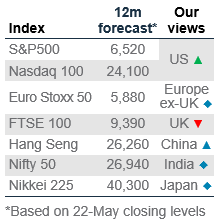
Fig. 13 Earnings expectations for global equities continue to rise, despite the recent pullback; US investor positioning is off extreme lows, but still implies further upside
Performance and 12m forward EPS of MSCI AC World index since 2015; S&P500 investor positioning and 3m forward returns based on performance since 2010
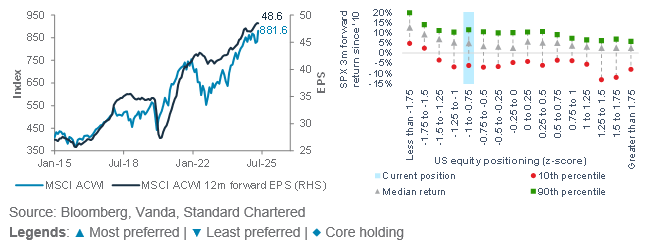
Tailwind from the ‘clarity factor’
We upgrade global equities to Overweight versus other asset classes. Fading tariff concerns and still-robust economic data are bolstering investor sentiment.
Within global equities, we upgrade US equities to Overweight. Q1 25 earnings beat expectations, with relatively resilient forward earnings guidance. The US-China temporary tariff rollback has reduced uncertainty on the earnings outlook and we expect further de-escalation in trade talks to support earnings projections. Elevated ROE justifies elevated US valuations (12m forward P/E at 19.5% premium to global stocks). Investor positioning in US equities has risen from extreme lows but there is still has scope for further upside.
We downgrade UK equities to Underweight. UK equities are heavy on defensive sectors, which go against our ‘pro-risk’ stance. We see positives from the UK’s trade deal with the US to be largely priced in following its strong rally since the ‘Liberation Day’.
We view Asia ex-Japan as a core holding. A weaker USD and de-escalation of tension between the US and China are
positives, but earnings revisions are poor. Within Asia ex-Japan, we are Overweight China equities. Domestic policies are supportive, such as easing monetary policy and fiscal support on technological innovations. Such policies should lend more tailwind to China onshore equities. However, China offshore equities have more attractive technology sector exposure. Hence, we move to a Neutral preference between onshore versus offshore China equities. India equities remain a core holding within Asia ex-Japan. India is relatively insulated from tariff concerns, but its 2025 earnings expectations are declining, and valuations are elevated.
Europe ex-UK equities remain a core holding. They benefit from rising fiscal and defence spending as well as further easing from the ECB. However, earnings growth projections for 2025 have moderated significantly since start of year and are likely to decline further should geopolitical tensions intensify.
Japan equities remain a core holding. The catalyst of improving corporate governance, e.g. share buybacks, remains; Nippon Individual Savings Account (NISA) programme continues to drive fund inflows. The stronger JPY and potential uncertainties from Japan’s general election in July act as headwinds.
Equity opportunistic views
|
Turning bullish on semiconductors
- US-listed semiconductors are our newest opportunistic idea. The thaw between the US and China brings ‘clarity’ to risk assets, reducing uncertainty for investors. Investors once again are able to refocus on the artificial intelligence (AI) trend, particularly the demand for semiconductors from higher-end AI.
- Within the US, we continue to prefer sectors with strong pricing power (technology software, communication services) or are likely beneficiaries of an economic soft-landing and deregulation (financials).
- Outside the US, we continue to prefer sectors with domestic exposure (Europe banks and China non-financial high-dividend SOEs) or those having an offsetting stimulus (Europe industrials and Hang Seng technology).
Opportunistic buy ideas
US-listed semiconductors (new): Guidance from the Q1 earnings season points to continued growth in AI spending. Markets have ‘graduated’ from concerns about lower computational demand from ‘low-cost’ AI models such as DeepSeek, to how such models help expand the size of the ‘AI pie’. Lower-than-expected AI spending is a risk.
US technology software: The software industry has been relatively resilient against tariffs, helped by its strong pricing power. A decline in the cost of AI tools supports software products and development. Weakness in corporate IT spending is a risk.
US communication services: Attractive growth continues with online entertainment and AI applications. Digital advertising may slow along with the tariffs, but this has been priced in. Advertising softness is a risk.
US major banks: They benefit from a soft landing in the US economy and deregulation, with potentially greater share buybacks. A sharp slowdown in the US economy is a risk.
Europe banks: They derive two-thirds of revenue from Europe and will benefit from Germany’s fiscal stimulus. Attractive dividends and share buybacks are supportive factors. A sharp slowdown in Europe’s economy is a risk.
Europe industrials: Europe’s plans to boost infrastructure and defence spending would support aerospace and
defence, electrical equipment and machinery companies. A downturn in Europe’s economy is a risk.
China non-financial high-dividend SOEs: Their predominantly domestic exposure means they will benefit from the government’s stimulus. Non-financial SOEs are less exposed to the troubled property sector. Adverse regulatory changes are a risk.
Hang Seng technology: Policymakers’ support for AI and technology development underpin the growth outlook. They are cheap versus their counterparts in the US. Weaker-than-expected stimulus is a risk.
Sector views: technology growth continues
We expand our US barbell strategy, upgrading the defensive utilities sector to Overweight, alongside the defensive healthcare sector and growth-oriented communication and technology sectors. In Europe, we downgrade energy to Underweight amid weak oil prices. In China, we maintain exposure to improving consumption and AI adoption with our preference for technology, communication and discretionary.
Fig. 14 Our sector views by region
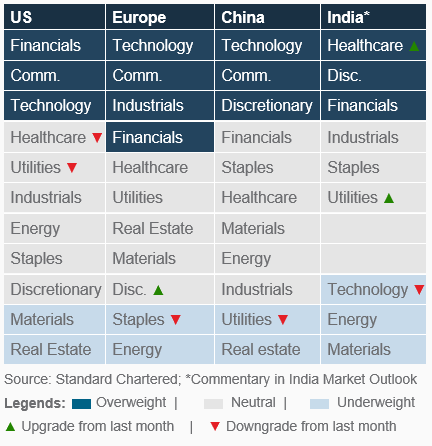
FX – at a glance
|
Key themes
We expect the USD to rebound in the near term before retreating over the next 12 months. Tariff de-escalation can take the USD Index (DXY) to 103 over the next 1-3 months, but concerns about US assets are likely to weigh in the longer term.
EUR/USD faces downside risk in the near-term but we would accumulate on dips. We expect the EUR/USD to ease back to 1.08 over the next three months, mirroring the near-term USD rebound. However, the improving growth outlook in Germany and narrowing rate differentials can take EUR/USD to 1.14 in 12 months.
Asian currencies likely rangebound. Our expectations for USD/SGD are perhaps most representative of our view on Asian currencies – we expect the pair to ease to 1.32 over the next three months before edging higher to 1.34 in 12 months as Asian central bank policy easing helps lean against recent appreciation pressure on their currencies.
Key chart
Recent USD weakness has mainly been against G7 currencies. The USD nominal effective exchange rate (NEER) is still above its long-term average.
Fig. 15 GBP and USD valuations remain above their five-year average; FX forecast table
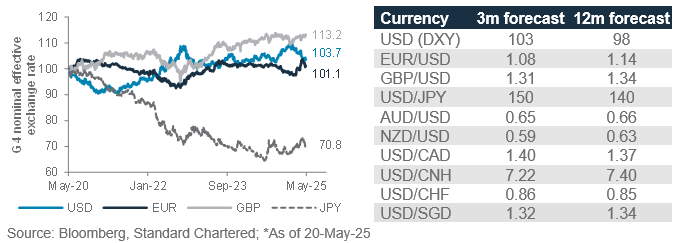
Clouds over the USD over the longer-term
The USD index (DXY) has fallen 8% year to date, weighed by trade uncertainty, widening fiscal deficits and waning investor confidence in US policies. US tariffs and the recent US credit rating downgrade have prompted investors to retreat from US assets. Ongoing trade negotiations and peaking tariff stress support a near-term rebound, but the US’ rising government debt continues to weigh on the USD.
In Europe, markets have priced in an ECB rate cut in June. ECB Governing Council members view current interest rates as sufficiently low and see less need for significantly more easing. We expect the EUR/USD to rebound in H2 25 and trade at 1.14 in 12 months, riding on a growth recovery in Germany and narrowing rate differentials.
We see GBP/USD trading around 1.31 in the near term and rise towards 1.34 over 6-12 months. Meanwhile, easing global trade tensions and fading risk aversion should support near-term upside in USD/JPY and USD/CHF. In particular, the trade-weighted CHF reached a record high in April, prompting market speculation about potential SNB intervention to weaken the currency. We see the possibility of negative Swiss interest rates by September.
Commodity currencies are expected to consolidate in the near term, with a modestly bullish bias over the 12-month horizon. Despite a dovish RBA, we see AUD/USD trading around 0.65 given improving risk appetite and CNY resilience. We see NZD/USD stabilising around 0.59. New Zealand’s monthly inflation is gaining momentum, which will limit RBNZ’s room to cut rates further. Canada has largely avoided additional reciprocal tariffs. With improving factory hiring towards year-end, we expect USD/CAD to trade around 1.37 over a 12-month horizon.
Asian currencies are diverging in performance. We have revised our USD/CNH forecasts lower amid easing trade tensions and expectations of a weaker USD over a 12-month horizon. However, China is expected to gradually guide the CNH weaker to support export competitiveness. The SGD NEER is trading near the stronger end of its band (1.6% above the midpoint). Slowing inflation and rising growth concerns are adding downside pressure on the SGD, with the trade ministry cutting its 2025 GDP growth forecast and the MAS recently lowering its core inflation target. As a result, we expect the SGD NEER to ease toward the midpoint of the policy band, pushing USD/SGD higher toward the 1.32-1.34 range.
Gold, crude oil – at a glance
|
|
||||
Key themes
We downgrade Gold to a core holding and expect a period of consolidation ahead. We trim our 3-month price expectation to USD 3,100 and leave our 12-month expectation unchanged at USD 3,500.
Our 12-month oil price forecast remains unchanged at USD 60/bbl amid still-significant supply. However, over a shorter1-3-month horizon, we expect prices to rebound towards USD 64/bbl.
Key chart
Fig. 16 Gold’s performance during Asian hours has cooled since the trade truce between the US and China
Average cumulative daily returns of gold during Asian hours
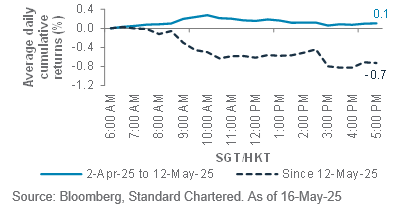
Fig. 18 Global central bank net gold purchases in Q1 25 remained strong relative to long-term history
Global central bank quarterly net gold purchases (tonnes)
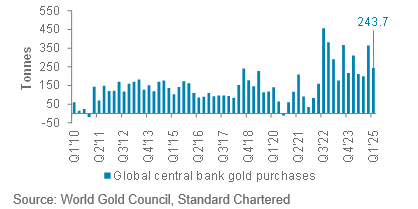
Fig. 17 Month-to-date flows into China gold ETFs turned negative in May
China gold ETF inflows
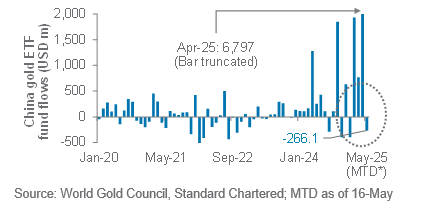
Fig. 19 The oil market is likely to remain in surplus this year, keeping prices in check
Oil supply-demand balance, price estimates
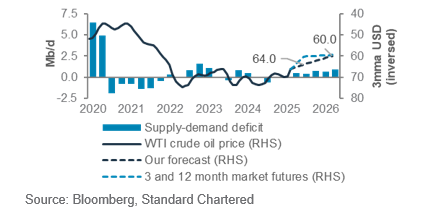
We have been Overweight on gold since September last year, and this has served us well, with gold prices rising over 20% during this period. However, with tariff concerns easing, we see an opportunity to tactically take profit. Structural tailwinds – particularly robust central bank demand – remain intact, but signs of buyer fatigue among Asian investors, a key source of recent demand, suggest further near-term downside. That said, we view the consolidation in prices as healthy following the extended rally. With lingering trade uncertainty and rising US deficit concerns as Trump shifts his focus toward tax cuts, gold is expected to be well supported by new baseline floor price of around USD 3,000-3,100/oz.
From a fundamental standpoint, oil markets continue to be oversupplied relative to expected demand. We expect this supply surplus to persist through 2025, exacerbated by a continued OPEC+ rollback of prior output cuts. Therefore, we leave our 6-12-month WTI oil price expectation unchanged at USD 60/bbl. Yet, over a shorter 1-3-month horizon, we raise our price expectation slightly to USD 64/bbl. This is driven by a combination of expected dialling back of excessively bearish investor positioning and short-term positive sentiment from China policy stimulus. Middle East geopolitical risk remains the key upside risk to oil prices.
Additional perspectives
Quant perspective
Slightly bullish equities short-term and long-term
|
|
||||
Summary
Our stock-bond model maintained a small Overweight in global equities due to valuation and technical factors. The model’s Overweight in equities over the past two months has helped to generate an outperformance (or alpha) of 1.1%, against the 60/40 equity-bond benchmark. While year-to-date alpha remains negative at -1.3% due to a weak global equity market between late March and early April, the model’s long-term outperformance since Feb-2023 remains strong and intact, with 3.8% alpha. Our model continues to favour equities, despite weak fundamentals (slower growth and earnings). Valuations of Developed Market (DM) and Asian equities remain attractive, and a strong market breadth should continue to support the recovery in global equities.
Our technical framework is bullish China, US and UK equities in the short term. Our models prefer markets with relatively lower volatility scores i.e., China, the US and the UK. Our models first turned bullish on China equities in late April, followed by the US and the UK in early May. These markets have gained 5.4%, 2.2% and 3.5%, respectively. We are Neutral Asia ex-Japan, Europe ex-UK and Japan over the next 1-3 months, based on technical readings. The MSCI Japan USD index has supportive price action and market regime indicators. It is now challenging its key resistance that it has failed to break since early 2023.
Investor positioning in gold and DM IG government bonds are no longer stretched. Our market diversity indicator, which uses price movements to deduce investor positioning in an asset, showed gold and DM Investment Grade government bonds were overbought in April. The indicator has now normalised for both assets, after the assets fell by 3.7% and 1.7%, respectively, below their April highs.
Key chart
Our stock-bond model score is at +1 (out of 5), as valuation and technical factors offset negative fundamental factors.
Fig. 20 Breakdown of our stock-bond rotation model’s scores since inception in Feb-23
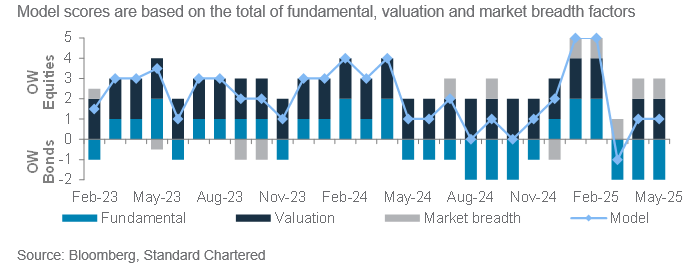
Our technical model upgraded the S&P500 to bullish bias in early April, with the closest resistance at 6,088 and the closest support at 5,476.
Fig. 21 Our technical model turned bullish on S&P500 in early May
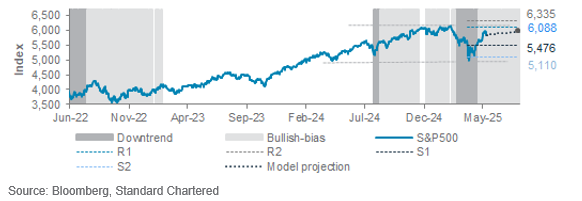
Fig. 22 Long- and short-term quantitative models are bullish risky assets
Long-term models below have a typical time horizon of 3-6 months, while short-term models have a 1-3-month horizon
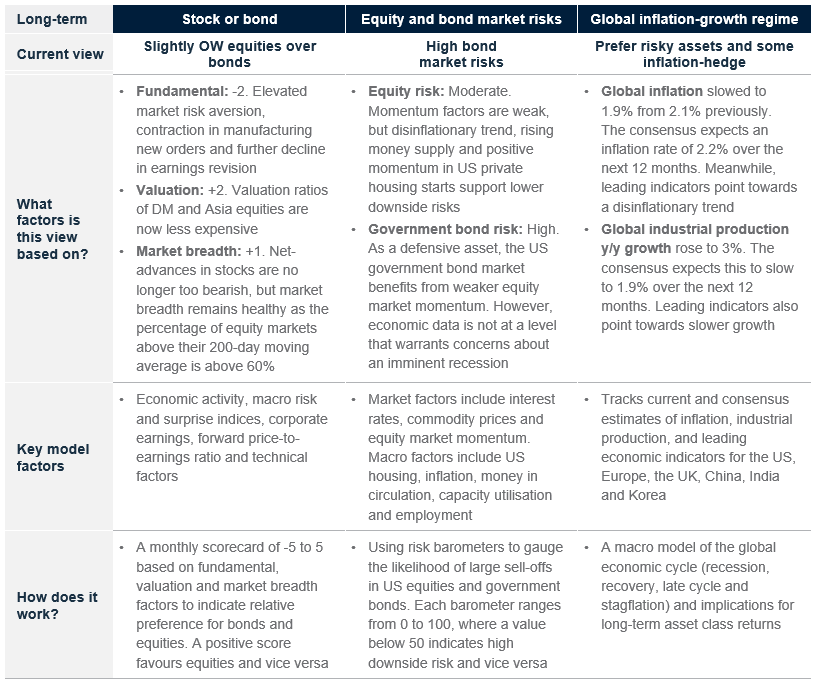
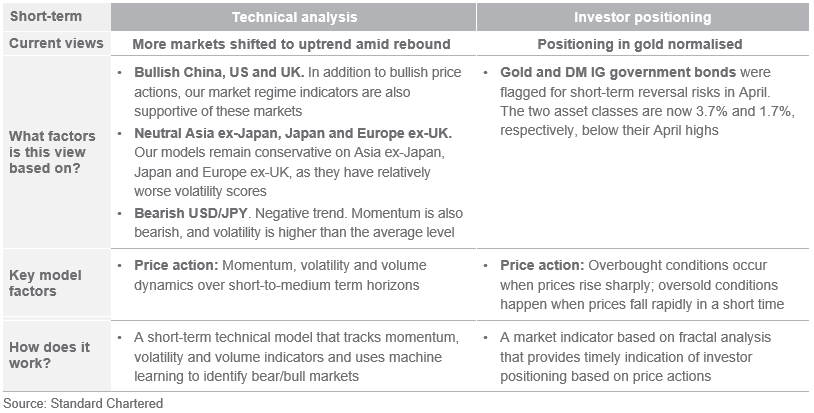
Performance review
Foundation: Asset allocation summary
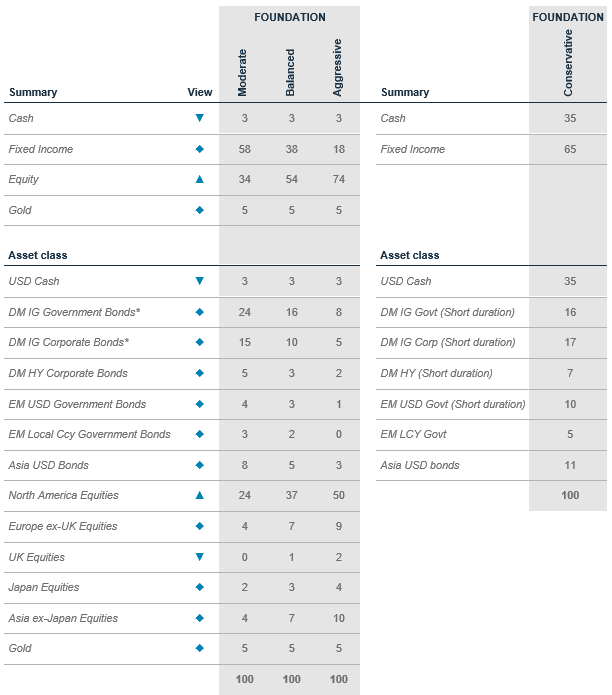

Foundation+: Asset allocation summary
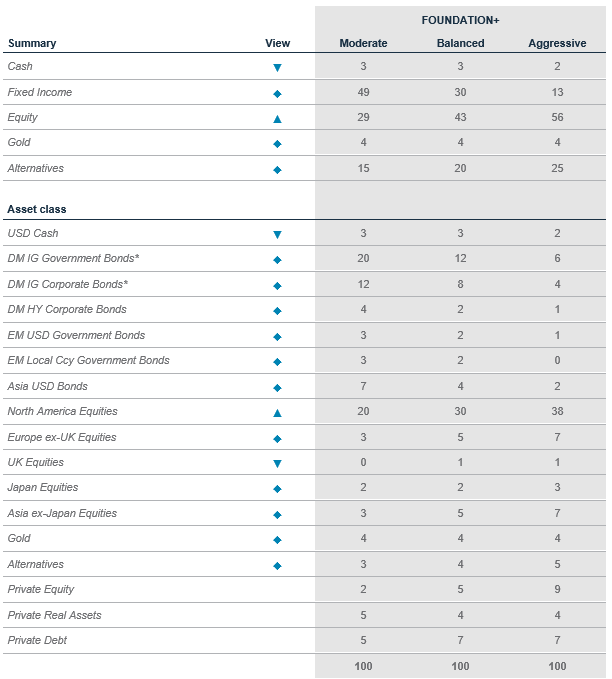

Market performance summary
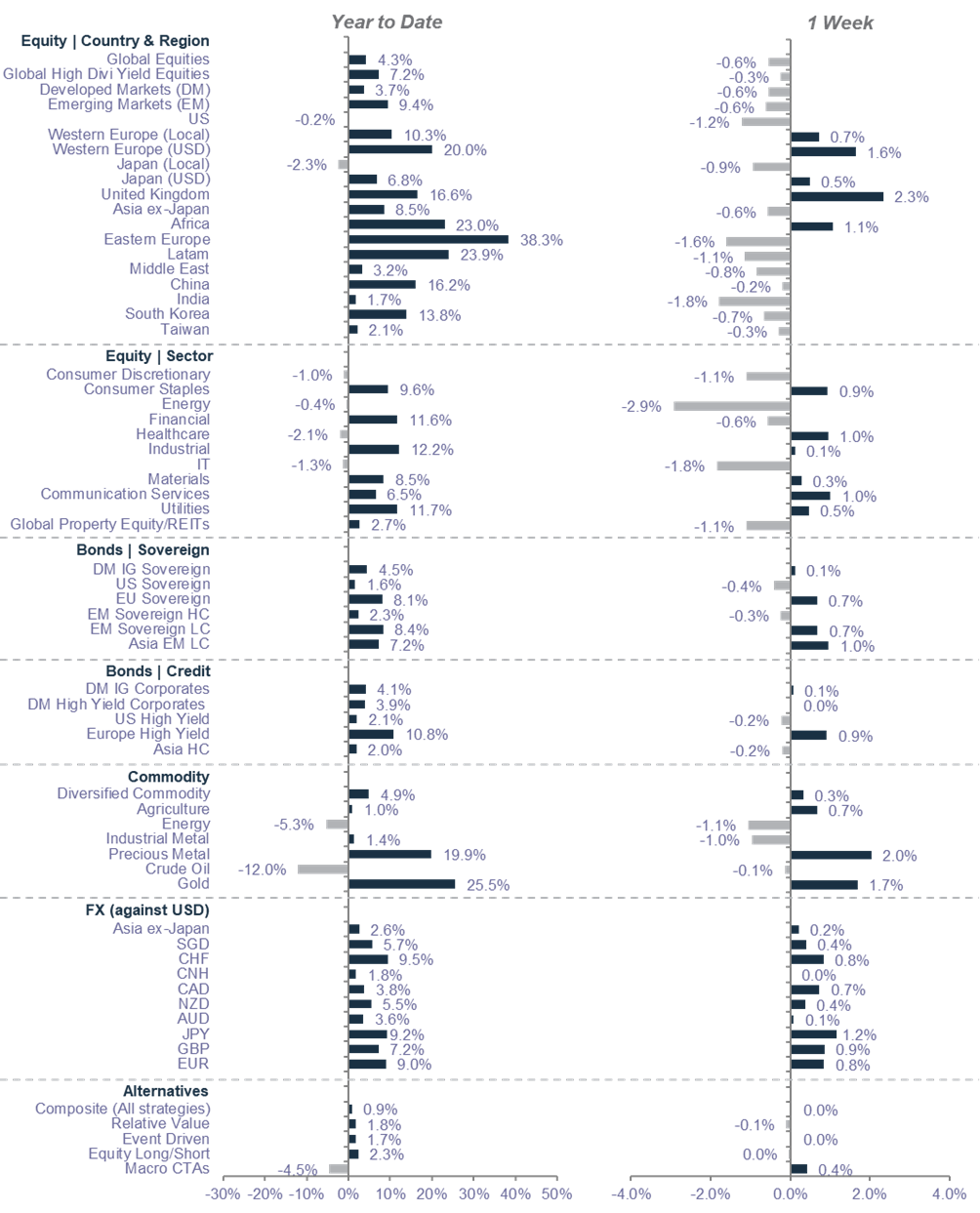
Source: MSCI, JPMorgan, Citigroup, Dow Jones, HFRX, FTSE, Bloomberg, Standard Chartered
*All performance shown in USD terms, unless otherwise stated
*YTD performance data from 31 December 2024 to 22 May 2025; 1-week performance from 15 to 22 May 2025
Our key forecasts and calendar events

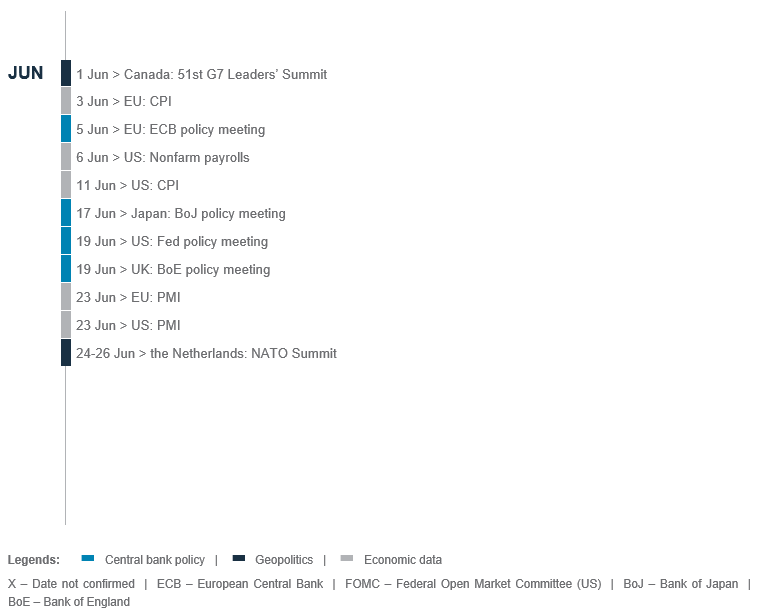
Today, Tomorrow and Forever

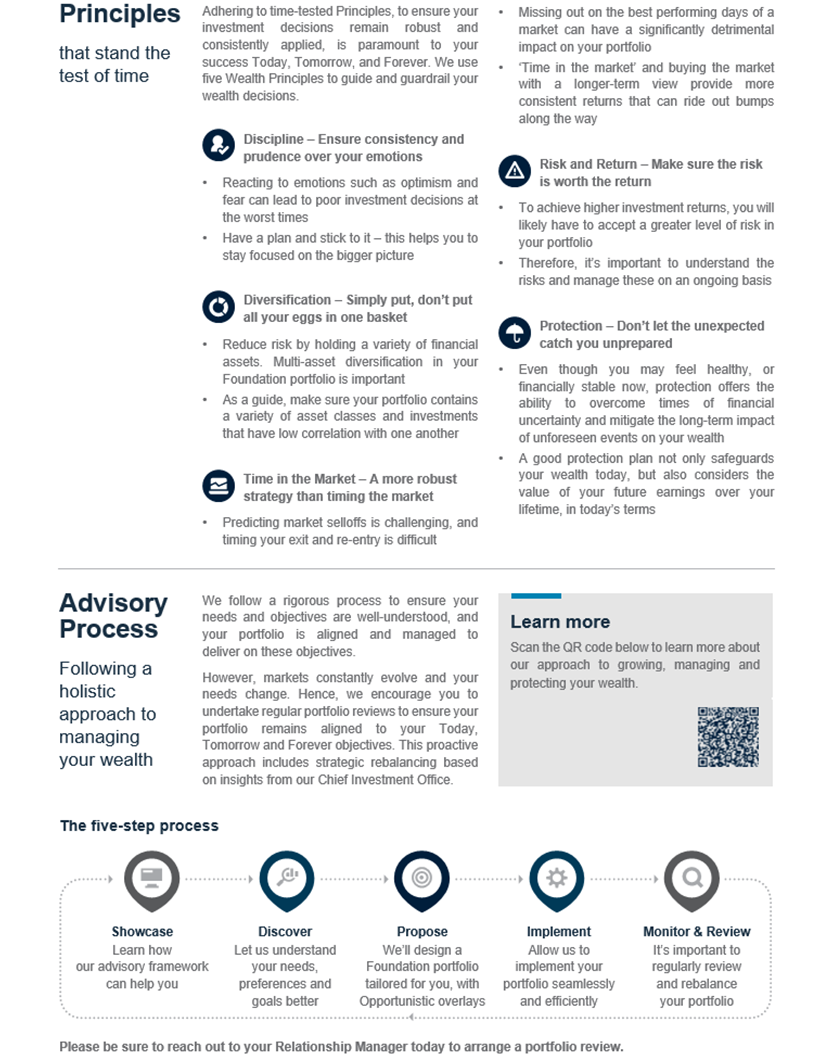

Explanatory notes
1. The figures on page 5 show allocations for a moderately aggressive risk profile only – different risk profiles may produce significantly different asset allocation results. Page 5 is only an example, provided for general information only and they do not constitute investment advice, an offer, recommendation or solicitation. They do not take into account the specific investment objectives, needs or risk tolerances of a particular person or class of persons and they have not been prepared for any particular person or class of persons.
2. Contingent Convertibles are complex financial instruments and are not a suitable or appropriate investment for all investors. This document is not an offer to sell or an invitation to buy any securities or any beneficial interests therein. Contingent convertible securities are not intended to be sold and should not be sold to retail clients in the European Economic Area (EEA) (each as defined in the Policy Statement on the Restrictions on the Retail Distribution of Regulatory Capital Instruments (Feedback to CP14/23 and Final Rules) (“Policy Statement”), read together with the Product Intervention (Contingent Convertible Instruments and Mutual Society Shares) Instrument 2015 (“Instrument”, and together with the Policy Statement, the “Permanent Marketing Restrictions”), which were published by the United Kingdom’s Financial Conduct Authority in June 2015), other than in circumstances that do not give rise to a contravention of the Permanent Marketing Restrictions.
Disclosure
This document is confidential and may also be privileged. If you are not the intended recipient, please destroy all copies and notify the sender immediately. This document is being distributed for general information only and is subject to the relevant disclaimers available at our Standard Chartered website under Regulatory disclosures. It is not and does not constitute research material, independent research, an offer, recommendation or solicitation to enter into any transaction or adopt any hedging, trading or investment strategy, in relation to any securities or other financial instruments. This document is for general evaluation only. It does not take into account the specific investment objectives, financial situation or particular needs of any particular person or class of persons and it has not been prepared for any particular person or class of persons. You should not rely on any contents of this document in making any investment decisions. Before making any investment, you should carefully read the relevant offering documents and seek independent legal, tax and regulatory advice. In particular, we recommend you to seek advice regarding the suitability of the investment product, taking into account your specific investment objectives, financial situation or particular needs, before you make a commitment to purchase the investment product. Opinions, projections and estimates are solely those of SC at the date of this document and subject to change without notice. Past performance is not indicative of future results and no representation or warranty is made regarding future performance. The value of investments, and the income from them, can go down as well as up, and you may not recover the amount of your original investment. You are not certain to make a profit and may lose money. Any forecast contained herein as to likely future movements in rates or prices or likely future events or occurrences constitutes an opinion only and is not indicative of actual future movements in rates or prices or actual future events or occurrences (as the case may be). This document must not be forwarded or otherwise made available to any other person without the express written consent of the Standard Chartered Group (as defined below). Standard Chartered Bank is incorporated in England with limited liability by Royal Charter 1853 Reference Number ZC18. The Principal Office of the Company is situated in England at 1 Basinghall Avenue, London, EC2V 5DD. Standard Chartered Bank is authorised by the Prudential Regulation Authority and regulated by the Financial Conduct Authority and Prudential Regulation Authority. Standard Chartered PLC, the ultimate parent company of Standard Chartered Bank, together with its subsidiaries and affiliates (including each branch or representative office), form the Standard Chartered Group. Standard Chartered Private Bank is the private banking division of Standard Chartered. Private banking activities may be carried out internationally by different legal entities and affiliates within the Standard Chartered Group (each an “SC Group Entity”) according to local regulatory requirements. Not all products and services are provided by all branches, subsidiaries and affiliates within the Standard Chartered Group. Some of the SC Group Entities only act as representatives of Standard Chartered Private Bank and may not be able to offer products and services or offer advice to clients.
Copyright © 2025, Accounting Research & Analytics, LLC d/b/a CFRA (and its affiliates, as applicable). Reproduction of content provided by CFRA in any form is prohibited except with the prior written permission of CFRA. CFRA content is not investment advice and a reference to or observation concerning a security or investment provided in the CFRA SERVICES is not a recommendation to buy, sell or hold such investment or security or make any other investment decisions. The CFRA content contains opinions of CFRA based upon publicly-available information that CFRA believes to be reliable and the opinions are subject to change without notice. This analysis has not been submitted to, nor received approval from, the United States Securities and Exchange Commission or any other regulatory body. While CFRA exercised due care in compiling this analysis, CFRA, ITS THIRD-PARTY SUPPLIERS, AND ALL RELATED ENTITIES SPECIFICALLY DISCLAIM ALL WARRANTIES, EXPRESS OR IMPLIED, INCLUDING, BUT NOT LIMITED TO, ANY WARRANTIES OF MERCHANTABILITY OR FITNESS FOR A PARTICULAR PURPOSE OR USE, to the full extent permitted by law, regarding the accuracy, completeness, or usefulness of this information and assumes no liability with respect to the consequences of relying on this information for investment or other purposes. No content provided by CFRA (including ratings, credit-related analyses and data, valuations, model, software or other application or output therefrom) or any part thereof may be modified, reverse engineered, reproduced or distributed in any form by any means, or stored in a database or retrieval system, without the prior written permission of CFRA, and such content shall not be used for any unlawful or unauthorized purposes. CFRA and any third-party providers, as well as their directors, officers, shareholders, employees or agents do not guarantee the accuracy, completeness, timeliness or availability of such content. In no event shall CFRA, its affiliates, or their third-party suppliers be liable for any direct, indirect, special, or consequential damages, costs, expenses, legal fees, or losses (including lost income or lost profit and opportunity costs) in connection with a subscriber’s, subscriber’s customer’s, or other’s use of CFRA’s content.
Market Abuse Regulation (MAR) Disclaimer
Banking activities may be carried out internationally by different branches, subsidiaries and affiliates within the Standard Chartered Group according to local regulatory requirements. Opinions may contain outright “buy”, “sell”, “hold” or other opinions. The time horizon of this opinion is dependent on prevailing market conditions and there is no planned frequency for updates to the opinion. This opinion is not independent of Standard Chartered Group’s trading strategies or positions. Standard Chartered Group and/or its affiliates or its respective officers, directors, employee benefit programmes or employees, including persons involved in the preparation or issuance of this document may at any time, to the extent permitted by applicable law and/or regulation, be long or short any securities or financial instruments referred to in this document or have material interest in any such securities or related investments. Therefore, it is possible, and you should assume, that Standard Chartered Group has a material interest in one or more of the financial instruments mentioned herein. Please refer to our Standard Chartered website under Regulatory disclosures for more detailed disclosures, including past opinions/ recommendations in the last 12 months and conflict of interests, as well as disclaimers. A covering strategist may have a financial interest in the debt or equity securities of this company/issuer. All covering strategist are licensed to provide investment recommendations under Monetary Authority of Singapore or Hong Kong Monetary Authority. This document must not be forwarded or otherwise made available to any other person without the express written consent of Standard Chartered Group.
Sustainable Investments
Any ESG data used or referred to has been provided by Morningstar, Sustainalytics, MSCI or Bloomberg. Refer to 1) Morningstar website under Sustainable Investing, 2) Sustainalytics website under ESG Risk Ratings, 3) MCSI website under ESG Business Involvement Screening Research and 4) Bloomberg green, social & sustainability bonds guide for more information. The ESG data is as at the date of publication based on data provided, is for informational purpose only and is not warranted to be complete, timely, accurate or suitable for a particular purpose, and it may be subject to change. Sustainable Investments (SI): This refers to funds that have been classified as ‘Sustainable Investments’ by Morningstar. SI funds have explicitly stated in their prospectus and regulatory filings that they either incorporate ESG factors into the investment process or have a thematic focus on the environment, gender diversity, low carbon, renewable energy, water or community development. For equity, it refers to shares/stocks issued by companies with Sustainalytics ESG Risk Rating of Low/Negligible. For bonds, it refers to debt instruments issued by issuers with Sustainalytics ESG Risk Rating of Low/Negligible, and/or those being certified green, social, sustainable bonds by Bloomberg. For structured products, it refers to products that are issued by any issuer who has a Sustainable Finance framework that aligns with Standard Chartered’s Green and Sustainable Product Framework, with underlying assets that are part of the Sustainable Investment universe or separately approved by Standard Chartered’s Sustainable Finance Governance Committee. Sustainalytics ESG risk ratings shown are factual and are not an indicator that the product is classified or marketed as “green”, “sustainable” or similar under any particular classification system or framework.
Country/Market Specific Disclosures
Botswana: This document is being distributed in Botswana by, and is attributable to, Standard Chartered Bank Botswana Limited which is a financial institution licensed under the Section 6 of the Banking Act CAP 46.04 and is listed in the Botswana Stock Exchange. Brunei Darussalam: This document is being distributed in Brunei Darussalam by, and is attributable to, Standard Chartered Bank (Brunei Branch) | Registration Number RFC/61 and Standard Chartered Securities (B) Sdn Bhd | Registration Number RC20001003. Standard Chartered Bank is incorporated in England with limited liability by Royal Charter 1853 Reference Number ZC18. Standard Chartered Securities (B) Sdn Bhd is a limited liability company registered with the Registry of Companies with Registration Number RC20001003 and licensed by Brunei Darussalam Central Bank as a Capital Markets Service License Holder with License Number BDCB/R/CMU/S3-CL and it is authorised to conduct Islamic investment business through an Islamic window. China Mainland: This document is being distributed in China by, and is attributable to, Standard Chartered Bank (China) Limited which is mainly regulated by National Financial Regulatory Administration (NFRA), State Administration of Foreign Exchange (SAFE), and People’s Bank of China (PBOC). Hong Kong: In Hong Kong, this document, except for any portion advising on or facilitating any decision on futures contracts trading, is distributed by Standard Chartered Bank (Hong Kong) Limited (“SCBHK”), a subsidiary of Standard Chartered PLC. SCBHK has its registered address at 32/F, Standard Chartered Bank Building, 4-4A Des Voeux Road Central, Hong Kong and is regulated by the Hong Kong Monetary Authority and registered with the Securities and Futures Commission (“SFC”) to carry on Type 1 (dealing in securities), Type 4 (advising on securities), Type 6 (advising on corporate finance) and Type 9 (asset management) regulated activity under the Securities and Futures Ordinance (Cap. 571) (“SFO”) (CE No. AJI614). The contents of this document have not been reviewed by any regulatory authority in Hong Kong and you are advised to exercise caution in relation to any offer set out herein. If you are in doubt about any of the contents of this document, you should obtain independent professional advice. Any product named herein may not be offered or sold in Hong Kong by means of any document at any time other than to “professional investors” as defined in the SFO and any rules made under that ordinance. In addition, this document may not be issued or possessed for the purposes of issue, whether in Hong Kong or elsewhere, and any interests may not be disposed of, to any person unless such person is outside Hong Kong or is a “professional investor” as defined in the SFO and any rules made under that ordinance, or as otherwise may be permitted by that ordinance. In Hong Kong, Standard Chartered Private Bank is the private banking division of SCBHK, a subsidiary of Standard Chartered PLC. Ghana: Standard Chartered Bank Ghana Limited accepts no liability and will not be liable for any loss or damage arising directly or indirectly (including special, incidental or consequential loss or damage) from your use of these documents. Past performance is not indicative of future results and no representation or warranty is made regarding future performance. You should seek advice from a financial adviser on the suitability of an investment for you, taking into account these factors before making a commitment to invest in an investment. To unsubscribe from receiving further updates, please send an email to feedback.ghana@sc.com. Please do not reply to this email. Call our Priority Banking on 0302610750 for any questions or service queries. You are advised not to send any confidential and/or important information to Standard Chartered via e-mail, as Standard Chartered makes no representations or warranties as to the security or accuracy of any information transmitted via e-mail. Standard Chartered shall not be responsible for any loss or damage suffered by you arising from your decision to use e-mail to communicate with the Bank. India: This document is being distributed in India by Standard Chartered in its capacity as a distributor of mutual funds and referrer of any other third party financial products. Standard Chartered does not offer any ‘Investment Advice’ as defined in the Securities and Exchange Board of India (Investment Advisers) Regulations, 2013 or otherwise. Services/products related securities business offered by Standard Charted are not intended for any person, who is a resident of any jurisdiction, the laws of which imposes prohibition on soliciting the securities business in that jurisdiction without going through the registration requirements and/or prohibit the use of any information contained in this document. Indonesia: This document is being distributed in Indonesia by Standard Chartered Bank, Indonesia branch, which is a financial institution licensed and supervised by Otoritas Jasa Keuangan (Financial Service Authority) and Bank Indonesia. Jersey: In Jersey, Standard Chartered Private Bank is the Registered Business Name of the Jersey Branch of Standard Chartered Bank. The Jersey Branch of Standard Chartered Bank is regulated by the Jersey Financial Services Commission. Copies of the latest audited accounts of Standard Chartered Bank are available from its principal place of business in Jersey: PO Box 80, 15 Castle Street, St Helier, Jersey JE4 8PT. Standard Chartered Bank is incorporated in England with limited liability by Royal Charter in 1853 Reference Number ZC 18. The Principal Office of the Company is situated in England at 1 Basinghall Avenue, London, EC2V 5DD. Standard Chartered Bank is authorised by the Prudential Regulation Authority and regulated by the Financial Conduct Authority and Prudential Regulation Authority. The Jersey Branch of Standard Chartered Bank is also an authorised financial services provider under license number 44946 issued by the Financial Sector Conduct Authority of the Republic of South Africa. Jersey is not part of the United Kingdom and all business transacted with Standard Chartered Bank, Jersey Branch and other SC Group Entity outside of the United Kingdom, are not subject to some or any of the investor protection and compensation schemes available under United Kingdom law. Kenya: This document is being distributed in Kenya by and is attributable to Standard Chartered Bank Kenya Limited. Investment Products and Services are distributed by Standard Chartered Investment Services Limited, a wholly owned subsidiary of Standard Chartered Bank Kenya Limited that is licensed by the Capital Markets Authority in Kenya, as a Fund Manager. Standard Chartered Bank Kenya Limited is regulated by the Central Bank of Kenya. Malaysia: This document is being distributed in Malaysia by Standard Chartered Bank Malaysia Berhad (“SCBMB”). Recipients in Malaysia should contact SCBMB in relation to any matters arising from, or in connection with, this document. This document has not been reviewed by the Securities Commission Malaysia. The product lodgement, registration, submission or approval by the Securities Commission of Malaysia does not amount to nor indicate recommendation or endorsement of the product, service or promotional activity. Investment products are not deposits and are not obligations of, not guaranteed by, and not protected by SCBMB or any of the affiliates or subsidiaries, or by Perbadanan Insurans Deposit Malaysia, any government or insurance agency. Investment products are subject to investment risks, including the possible loss of the principal amount invested. SCBMB expressly disclaim any liability and responsibility for any loss arising directly or indirectly (including special, incidental or consequential loss or damage) arising from the financial losses of the Investment Products due to market condition. Nigeria: This document is being distributed in Nigeria by Standard Chartered Bank Nigeria Limited (SCB Nigeria), a bank duly licensed and regulated by the Central Bank of Nigeria. SCB Nigeria accepts no liability for any loss or damage arising directly or indirectly (including special, incidental or consequential loss or damage) from your use of these documents. You should seek advice from a financial adviser on the suitability of an investment for you, taking into account these factors before making a commitment to invest in an investment. To unsubscribe from receiving further updates, please send an email to clientcare.ng@sc.com requesting to be removed from our mailing list. Please do not reply to this email. Call our Priority Banking on 02 012772514 for any questions or service queries. SCB Nigeria shall not be responsible for any loss or damage arising from your decision to send confidential and/or important information to Standard Chartered via e-mail. SCB Nigeria makes no representations or warranties as to the security or accuracy of any information transmitted via e-mail. Pakistan: This document is being distributed in Pakistan by, and attributable to Standard Chartered Bank (Pakistan) Limited having its registered office at PO Box 5556, I.I Chundrigar Road Karachi, which is a banking company registered with State Bank of Pakistan under Banking Companies Ordinance 1962 and is also having licensed issued by Securities & Exchange Commission of Pakistan for Security Advisors. Standard Chartered Bank (Pakistan) Limited acts as a distributor of mutual funds and referrer of other third-party financial products. Singapore: This document is being distributed in Singapore by, and is attributable to, Standard Chartered Bank (Singapore) Limited (Registration No. 201224747C/ GST Group Registration No. MR-8500053-0, “SCBSL”). Recipients in Singapore should contact SCBSL in relation to any matters arising from, or in connection with, this document. SCBSL is an indirect wholly owned subsidiary of Standard Chartered Bank and is licensed to conduct banking business in Singapore under the Singapore Banking Act, 1970. Standard Chartered Private Bank is the private banking division of SCBSL. IN RELATION TO ANY SECURITY OR SECURITIES-BASED DERIVATIVES CONTRACT REFERRED TO IN THIS DOCUMENT, THIS DOCUMENT, TOGETHER WITH THE ISSUER DOCUMENTATION, SHALL BE DEEMED AN INFORMATION MEMORANDUM (AS DEFINED IN SECTION 275 OF THE SECURITIES AND FUTURES ACT, 2001 (“SFA”)). THIS DOCUMENT IS INTENDED FOR DISTRIBUTION TO ACCREDITED INVESTORS, AS DEFINED IN SECTION 4A(1)(a) OF THE SFA, OR ON THE BASIS THAT THE SECURITY OR SECURITIES-BASED DERIVATIVES CONTRACT MAY ONLY BE ACQUIRED AT A CONSIDERATION OF NOT LESS THAN S$200,000 (OR ITS EQUIVALENT IN A FOREIGN CURRENCY) FOR EACH TRANSACTION. Further, in relation to any security or securities-based derivatives contract, neither this document nor the Issuer Documentation has been registered as a prospectus with the Monetary Authority of Singapore under the SFA. Accordingly, this document and any other document or material in connection with the offer or sale, or invitation for subscription or purchase, of the product may not be circulated or distributed, nor may the product be offered or sold, or be made the subject of an invitation for subscription or purchase, whether directly or indirectly, to persons other than a relevant person pursuant to section 275(1) of the SFA, or any person pursuant to section 275(1A) of the SFA, and in accordance with the conditions specified in section 275 of the SFA, or pursuant to, and in accordance with the conditions of, any other applicable provision of the SFA. In relation to any collective investment schemes referred to in this document, this document is for general information purposes only and is not an offering document or prospectus (as defined in the SFA). This document is not, nor is it intended to be (i) an offer or solicitation of an offer to buy or sell any capital markets product; or (ii) an advertisement of an offer or intended offer of any capital markets product. Deposit Insurance Scheme: Singapore dollar deposits of non-bank depositors are insured by the Singapore Deposit Insurance Corporation, for up to S$100,000 in aggregate per depositor per Scheme member by law. Foreign currency deposits, dual currency investments, structured deposits and other investment products are not insured. This advertisement has not been reviewed by the Monetary Authority of Singapore. Taiwan: SC Group Entity or Standard Chartered Bank (Taiwan) Limited (“SCB (Taiwan)”) may be involved in the financial instruments contained herein or other related financial instruments. The author of this document may have discussed the information contained herein with other employees or agents of SC or SCB (Taiwan). The author and the above-mentioned employees of SC or SCB (Taiwan) may have taken related actions in respect of the information involved (including communication with customers of SC or SCB (Taiwan) as to the information contained herein). The opinions contained in this document may change, or differ from the opinions of employees of SC or SCB (Taiwan). SC and SCB (Taiwan) will not provide any notice of any changes to or differences between the above-mentioned opinions. This document may cover companies with which SC or SCB (Taiwan) seeks to do business at times and issuers of financial instruments. Therefore, investors should understand that the information contained herein may serve as specific purposes as a result of conflict of interests of SC or SCB (Taiwan). SC, SCB (Taiwan), the employees (including those who have discussions with the author) or customers of SC or SCB (Taiwan) may have an interest in the products, related financial instruments or related derivative financial products contained herein; invest in those products at various prices and on different market conditions; have different or conflicting interests in those products. The potential impacts include market makers’ related activities, such as dealing, investment, acting as agents, or performing financial or consulting services in relation to any of the products referred to in this document. UAE: DIFC – Standard Chartered Bank is incorporated in England with limited liability by Royal Charter 1853 Reference Number ZC18.The Principal Office of the Company is situated in England at 1 Basinghall Avenue, London, EC2V 5DD. Standard Chartered Bank is authorised by the Prudential Regulation Authority and regulated by the Financial Conduct Authority and Prudential Regulation Authority. Standard Chartered Bank, Dubai International Financial Centre having its offices at Dubai International Financial Centre, Building 1, Gate Precinct, P.O. Box 999, Dubai, UAE is a branch of Standard Chartered Bank and is regulated by the Dubai Financial Services Authority (“DFSA”). This document is intended for use only by Professional Clients and is not directed at Retail Clients as defined by the DFSA Rulebook. In the DIFC we are authorised to provide financial services only to clients who qualify as Professional Clients and Market Counterparties and not to Retail Clients. As a Professional Client you will not be given the higher retail client protection and compensation rights and if you use your right to be classified as a Retail Client we will be unable to provide financial services and products to you as we do not hold the required license to undertake such activities. For Islamic transactions, we are acting under the supervision of our Shariah Supervisory Committee. Relevant information on our Shariah Supervisory Committee is currently available on the Standard Chartered Bank website in the Islamic banking section. For residents of the UAE – Standard Chartered Bank UAE does not provide financial analysis or consultation services in or into the UAE within the meaning of UAE Securities and Commodities Authority Decision No. 48/r of 2008 concerning financial consultation and financial analysis. Uganda: Our Investment products and services are distributed by Standard Chartered Bank Uganda Limited, which is licensed by the Capital Markets Authority as an investment adviser. United Kingdom: In the UK, Standard Chartered Bank is authorised by the Prudential Regulation Authority and regulated by the Financial Conduct Authority and Prudential Regulation Authority. This communication has been approved by Standard Chartered Bank for the purposes of Section 21 (2) (b) of the United Kingdom’s Financial Services and Markets Act 2000 (“FSMA”) as amended in 2010 and 2012 only. Standard Chartered Bank (trading as Standard Chartered Private Bank) is also an authorised financial services provider (license number 45747) in terms of the South African Financial Advisory and Intermediary Services Act, 2002. The Materials have not been prepared in accordance with UK legal requirements designed to promote the independence of investment research, and that it is not subject to any prohibition on dealing ahead of the dissemination of investment research. Vietnam: This document is being distributed in Vietnam by, and is attributable to, Standard Chartered Bank (Vietnam) Limited which is mainly regulated by State Bank of Vietnam (SBV). Recipients in Vietnam should contact Standard Chartered Bank (Vietnam) Limited for any queries regarding any content of this document. Zambia: This document is distributed by Standard Chartered Bank Zambia Plc, a company incorporated in Zambia and registered as a commercial bank and licensed by the Bank of Zambia under the Banking and Financial Services Act Chapter 387 of the Laws of Zambia.
